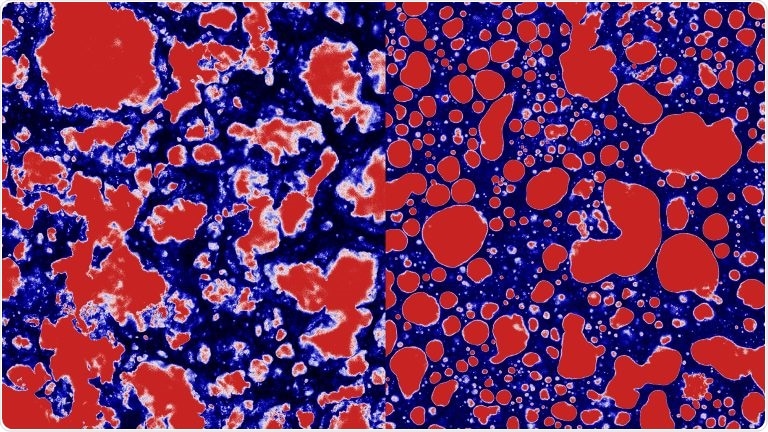Food texture is likely to be the reason between passing on a plate and love at first bite. Until today, the majority of the researches on food texture focuses on associating a food’s overall composition to its mechanical properties. The knowledge of how microscopic structure and differences in the shape of food impacts food texture is yet underdeveloped.

Microscopic structure of fat (red) explains texture differences between foie gras (left) and pâté (right). Image Credit: Matias A. Via and Mathias P. Clausen.
Scientists from Denmark and Germany carried out a series of experiments in connection to food microstructure and rheology, the research of how soft solids and some liquids deform, to texture. The researchers employed coherent anti-Stokes Raman scattering (CARS) microscopy to associate the molecular makeup of the fat in foods with the rheological and mechanical properties of the food.
The research was published in the Physics of Fluids journal, by AIP Publishing.
The foods in question were foie gras and pâté.
Using soft matter physics tools and models, we connected structural information in the food across length scales. We joined microscopy and rheology to understand the mouthfeel of food from a gastrophysical standpoint.”
Thomas Vilgis, Study Author, Max Planck Institute for Polymer Research
Both the dishes are derived from duck livers and the two dishes are similar in overall structure, and their varying fat distribution offered a new understanding of how fat affects texture.
There are further different interesting aspects that can be targeted to create new products with the same features as these products. Can we create foie gras-like textures without animal cruelty? Can we create melting and creamy texture from different fat sources?”
Mathias P. Clausen, Study Author, Department of Green Technology, University of Southern Denmark
To find the answer to these questions, the researchers relied on CARS microscopy, which employs lasers to vibrate chemical bonds in foods to tunable frequencies and induce them to emit light. The technique was used for a long time in other areas; however, it was not used extensively in food science.
The fat present in foie gras was arranged into an irregularly shaped, weakly associated fat network enclosed in a protein matrix, which was the reason behind mouthfeel being harder, more elastic, and more brittle when compared to pâté.
The increased number of smoother and rounder fat particles and the absence of an interconnected network was the reason for the pâté’s softer texture.
Clausen expects that the current study would ignite further interest in analyzing which microscopic features of foods can be tweaked. The researchers also intend to examine other components of foods with advanced microscopy—like protein arrangement—and see if they can utilize their observations to produce foods that imitate the texture of foie gras.
Source:
Journal reference:
Via, M. A., et al. (2021) Microscopic characterization of fatty liver-based emulsions: Bridging microstructure and texture in foie gras and pâté. Physics of Fluids. doi.org/10.1063/5.0070998.